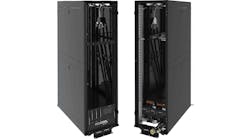The leading standards group for cooling professionals is once again preparing guidelines for data center construction inspectors, trying to improve on a 2010 update that drew sharp critiques from the industry.
Officials from ASHRAE say they are working with key players in the data center sector, and are eager to ensure that the standards reflect best practices. But it’s clear that bruised feelings remain from ASHRAE’s last foray into data center standards, and early versions of the proposed Standard 90.4 for data centers have raised alarms among some in the industry.
Several data center executives expressed concern about the use of Power Usage Effectiveness (PUE) goals for new data center construction, while others were skeptical that the ASHRAE standards process could keep up with the rapid pace of innovation in data center cooling.
ASHRAE updated its draft of standard 90.4 last month, revising some elements that had prompted concerns, according to committee chairman Ron Jarnagin. The revised standard will be republished in August, when data center professionals will have 45 days to comment and suggest revisions. A final version of the standard could be completed in October.
“I encourage people to raise their concerns so we discuss them before they’re in the standard,” said Jarnagin. “We have to be completely transparent in the things that we do. We want people with a big stake in it to have a say. We are not trying to do this without people knowing about it.”
Why Worries Persist
Data center executives worry that new rules on cooling could create expensive headaches for data center operators.
“I think very few data center operators understand what’s going on in ASHRAE and how it might impact them,” said Joe Kava, Vice President, Data Centers at Google. “These standards have to be very carefully thought through and written. The implications might be significant.”
“It’s alarming how many companies in this industry are not aware of this,” said Chris Crosby, CEO of Compass Datacenters. “There’s no real call to arms.”
At last month’s 7×24 Exchange conference, one of the industry’s leading liaisons with ASHRAE urged data center professionals to get involved in the process.
“The industry has got to rally,” said Don Beaty of DLB Associates, a past chair of ASHRAE Technical Committee 9.9 (TC9.9) for data center technology. “You shouldn’t use formal standards in a rapidly growing, fast-moving industry.”
What’s clear is that the upcoming final review period for Standard 90.4 represents an opportunity for both ASHRAE and the data center industry. For the industry, it’s an opportunity to better engage with a body that will be updating the standards for local data center construction for years to come. For ASHRAE, it’s an opportunity to build trust and forge a better relationship with data center thought leaders.
To receive notifications when the updated draft standard is published and participate in comments, you must subscribe to an ASHRAE email list. Go to the ASHRAE list subscription page and find the list titled “SPC 90.4” and enter your email.
Why ASHRAE Matters
Before diving into the current standards discussion, it’s important to understand the role of ASHRAE and its history with data centers.
ASHRAE develops standards for heating, ventilation, air conditioning and refrigeration that provide guidance for local officials in towns and cities across America. These inspection and code enforcement officials – known broadly as “authorities having jurisdiction” or AHJs – wield tremendous influence over construction projects.
“Inspectors and officials who give permits can interpret the code how they want,” said Crosby. “You have to do what the official tells you. Interpretation (of codes) can be critical for us. This is a big deal, especially in areas where officials aren’t familiar with data centers.”
“ASHRAE doesn’t mandate what the AHJs have to do, but they may be influenced (by standards),” said Kava.
These concerns were at the heart of the 2010 controversy over ASHRAE’s update of Standard 90.1, which governs commercial buildings. Leading executives from Google, Microsoft, Amazon, Digital Realty Trust, DuPont Fabros Technology, IBM and Nokia signed a joint letter urging ASHRAE to avoid prescribing the use of economizers as the preferred method for cooling data centers.
They called on ASHRAE to instead adopt an overall efficiency standard for data center cooling, focusing on results rather than methodology. Google’s Urz Hoelzle noted that the signatories “collectively represent most of the world’s most advanced data center operators.”
Despite the protest, ASHRAE insisted the changes to 90.1 would not force data center builders to use economizers in new facilities, but will leave room for companies to use other approaches.
The dispute was a factor in this year’s development of Standard 90.4 for data centers and telecommunications facilities. Jarnagin said TC9.9 put in a request that ASHRAE write a separate data center standard. “They thought it was needed,” said Jarnagin. “There was a sense that some of the (work of 90.1) was infringing on the data center world.”
ASHRAE asked Jarnagin to form a committee to develop the standard. Jarnagin, who worked for many years as a staff scientist at the Department of Energy’s Pacific Northwest National Laboratory, is not a data center specialist. However, his 30 years of volunteer work with ASHREA includes extensive experience in standards development, including a term as chair of the Standard 90.1 committee.
“We have people on the committee that work in and around data centers, and some manufacturers of cooling equipment,” said Jarnagin. “Almost all of the people on the committee have expertise in data centers.”
The 90.4 committee includes representatives of Schneider Electric, Emerson and Trane, as well as executives with extensive experience in data center design, including Jack Glass from Citigroup, Vali Sorell of Syska Hennessy Group, Jeff Sloan of McKinstry and David Quirk of DLB Associates, who currently heads TC9.9. In all, five members of the 90.4 committee are also on TC9.9.
The Lengthy Path to a Standard
The committee was created in 2013, but the first publication of the 90.4 standard for data centers was announced in a press release on Feb. 20, and mentioned on ASHRAE’s Twitter account. The standard aims to “establish the minimum energy efficiency requirements of data centers and telecommunications buildings.”
ASHRAE was clear from the start that PUE would play an important role. “This standard is based on the principles of power use effectiveness (PUE), as defined by The Green Grid,” the announcement said.
But the group also noted that there would be other ways to measure the energy efficiency of a data center design. “By using an approach that requires compliance to a ‘system’ level of performance, designers and end-users can utilize various trade-offs in their optimization strategizes depending on their company specific business models,” said Quirk, the chair of TC9.9.
The use of PUE and a system-level approach were two of the requests in the 2010 letter from data center industry leaders to ASHRAE about the changes to standard 90.1. The first task was to determine how 90.4 would work with 90.1. Jarnagin said the 90.4 standard would only cover issues specific to data centers, and work in concert with 90.1. He said the committee also took time to ensure new members understood the process.
“A lot of the people on TC9.9 are not familiar with standards and processes,” said Jarnagin. “Some of what we do is make sure we educate them in the processes we follow.
“I’m sure people in the data center industry were not widely aware (of the 90.4 process),” he added. “We got a reasonable number of comments and used that to put out a publication for public review. I think that’s when most of the data center industry woke up and started paying attention.”
Concerns Emerge
One of those paying attention to the first review was Crosby, who in 2010 had helped mobilize the industry response to the 90.1 standard, and expressed concern on a number of fronts.
“You can interpret it in a way that when you have to replace a CRAC, you have to upgrade all the CRAC units at the same time,” said Crosby. “You’re talking about a huge impact upon public companies if this goes through. There could be massive asset impairment. This isn’t a technical issue. This is an asset impairment and CAPEX disaster.”
Beaty said he shared Crosby’s concern that AHJs could interpret the draft standard 90.4 in ways that prompt additional investment for data center operators. Beaty, who for years has teamed with IBM’s Roger Schmidt in conference presentations on ASHRAE cooling guidelines, also sees potential problems with how PUE is being used in 90.4.
“The problem is a prescriptive standard,” said Beaty.
“It really impacts the colo and interconnection facilities,” said Crosby. “PUE is incredibly dependent upon the user’s load and the climate. A lot of colos can be 80 percent leased and also have 30 percent load. PUE was never intended to be that kind of metric.”
Others in the industry seem more comfortable with the goals of the 90.4 standard, including John Bean, Director of Innovation and Technology for Schneider Electric. “There will be a big focus on working toward some minimum efficiencies,” Bean said. “Rather than stating ‘you must do this and this,’ there will be a minimum efficiency and you can do it however you want to get there.” Bean is on the 90.4 standards committee.
Jarnagin said the latest update to the 90.4 standard will include specific goals for PUE.
“There are some PUE numbers,” he said. “(Committee members) seem to think these PUEs are fairly easy to hit. Some thought we should have gone farther. One of the discussions was the definition of PUE and the fact that PUEs are measured data. We’re talking about design PUEs. We’ve allowed for some tradeoffs on the mechanical and electrical side to allow a design PUE. There is some flexibility. We put a lot of emphasis on defining what the designer would have to present to the AHJ so they could make an informed decision. We’re trying to make clear what we’re covering and what we’re not covering. I think this certainly will be manageable.”
At the ASHRAE conference in Atlanta in late June, the 90.4 committee responded to comments and concerns and made some revisions to the standard. Despite the reservations expressed by some in the industry, Jarnagin said it was not a contentious discussion.
“I don’t recall any strong objections to what we were doing,” he said. “There was not any conflict in the room, which included some people from the data center industry.
“The one area that got the most attention was the inclusion of telecommunications facilities in the title and mandate,” said Jarnagin. “That was how TC9.9 proposed it, but it became pretty clear that trying to deal with telecom buildings would be problematic. So we changed the title and scope, and it’s now just data centers.”
Jarnagin said he did not recall any specific concerns about the standard prompting retrofits or capital equipment expenses.
The End Game
A major challenge in assessing the status of the proposal is that the updated document is not currently available.
“The proposed standards or addenda are only available during public review,” said Jodi Scott, Communications Manager for ASHRAE. “This is because we don’t want the industry using guidance and requirements in documents that are in draft form (meaning the information is likely to change from draft to draft). So for now, the draft is not available.”
Another issue is that ASHRAE doesn’t have a page on its web site to provide information on the standard, milestone dates or who is on the committee (unlike TC9.9, which has a dedicated web site). Updates are all via mailing list, and the review of the documents and commenting is all done via an online system.
Once the standards document is made available for review, there will be a 45-day comments period. Jarnagin says the committee must review every comment. “We usually engage in a dialogue (with commenters), which would be in through email or conference call. We expect that people that have concerns will express them. When we deal with the comments, every comment will be treated as equal.”
Jarnagin said that a “deluge” of comments focused on a specific point is less helpful than a single well-outlined comment. “That’s a tactic used by some people,” he said.
An Ongoing Discussion
Once the 90.4 standard is finalized, Jarnagin expects that the 90.4 committee will become a standing committee that can make regular updates to the standard as innovation continues. “The data center industry is dynamic, and will undergo a lot of change,” he said.
Jarnagin said the 90.1 committee does not have to sign off on 90.4 in any way. “That does not mean that interested parties from 90.1 will not comment, and I expect some will,” he said. “There are some California firms that have a real strong bias towards new data centers being built with economizers. They are strong believers in air-side economizers.”
He says that the 90.4 committee was more sensitive to the geographic factors affecting free cooling.
“People didn’t like where 90.1 was going (on economizers) and it seemed to be driven by people in a part of the country where that works,” said Jarnagin. “I don’t believe the orientation of my committee is to require economizers where they don’t make sense.”
It will be up to the data center community to make its opinions heard during the comment period. Beaty noted that the data center sector has been less engaged in the ASHRAE process than many other industries. He said standards development can sometimes prompt thousands or even tens of thousands of comments. That hasn’t been the case with 90.4.
Some see the need for the data center industry to be more organized. “We need some semblance of a lobbying organization in our industry,” said Crosby. “ASHRAE is financed by groups that want to regulate us. This is why other industries have lobbying organizations to represent their interests. This is a big, bureaucratic fight.”
Jarnagin says that at the end of the process, it’s about providing clear guidance to the local officials that inspect data centers.
“We have had a lot of intense conversations about AHJs and how they would interpret things,” he said. “We went through a lot of scenarios about what AHJs need to understand. I’m confident we’ve done as much as we can.”






